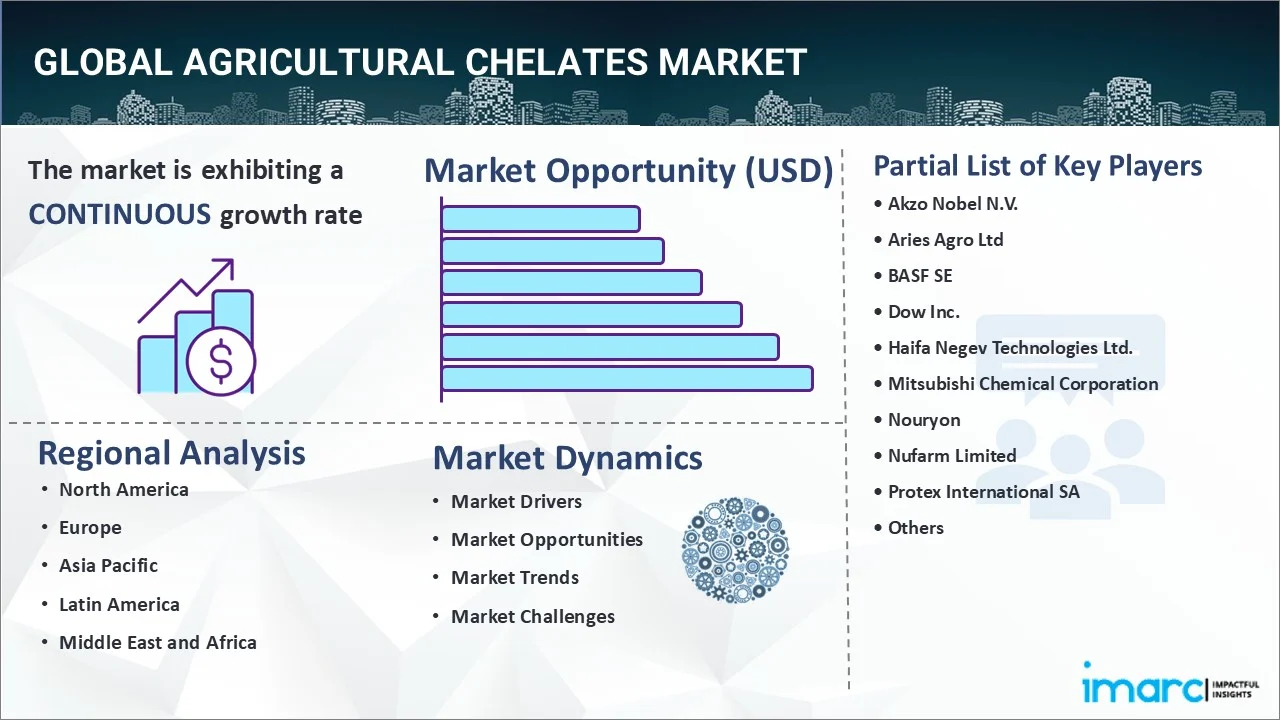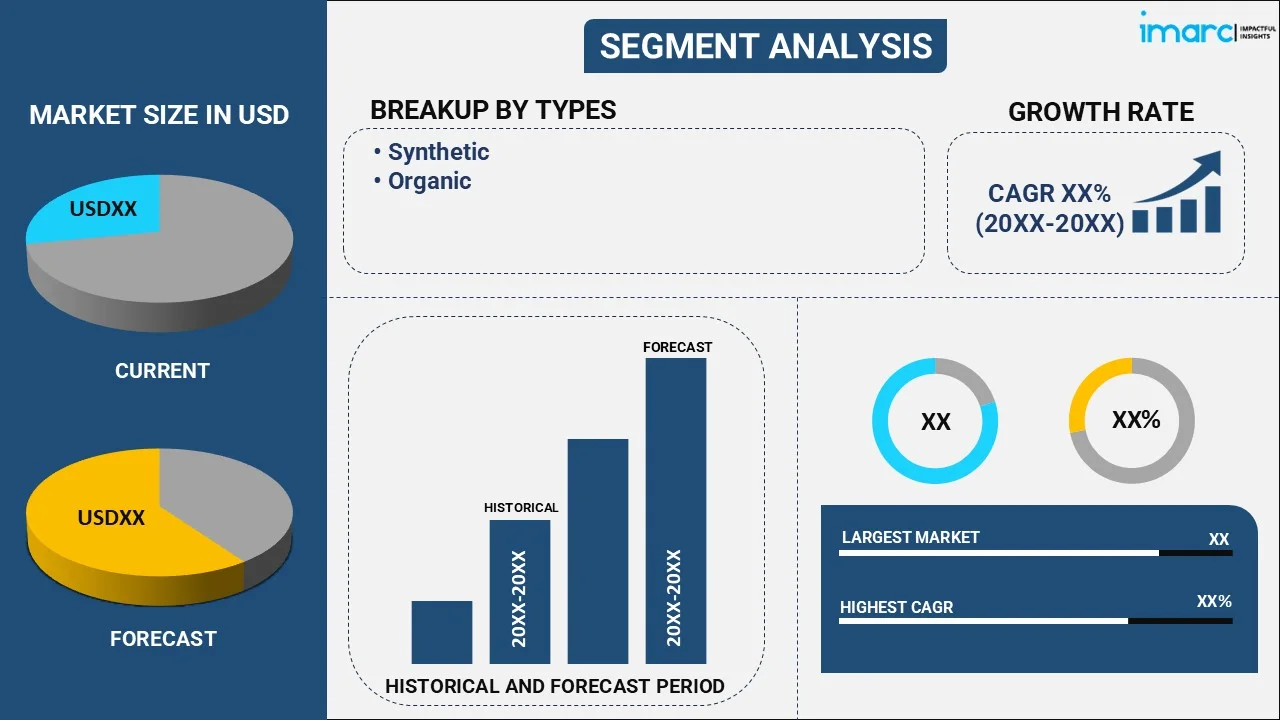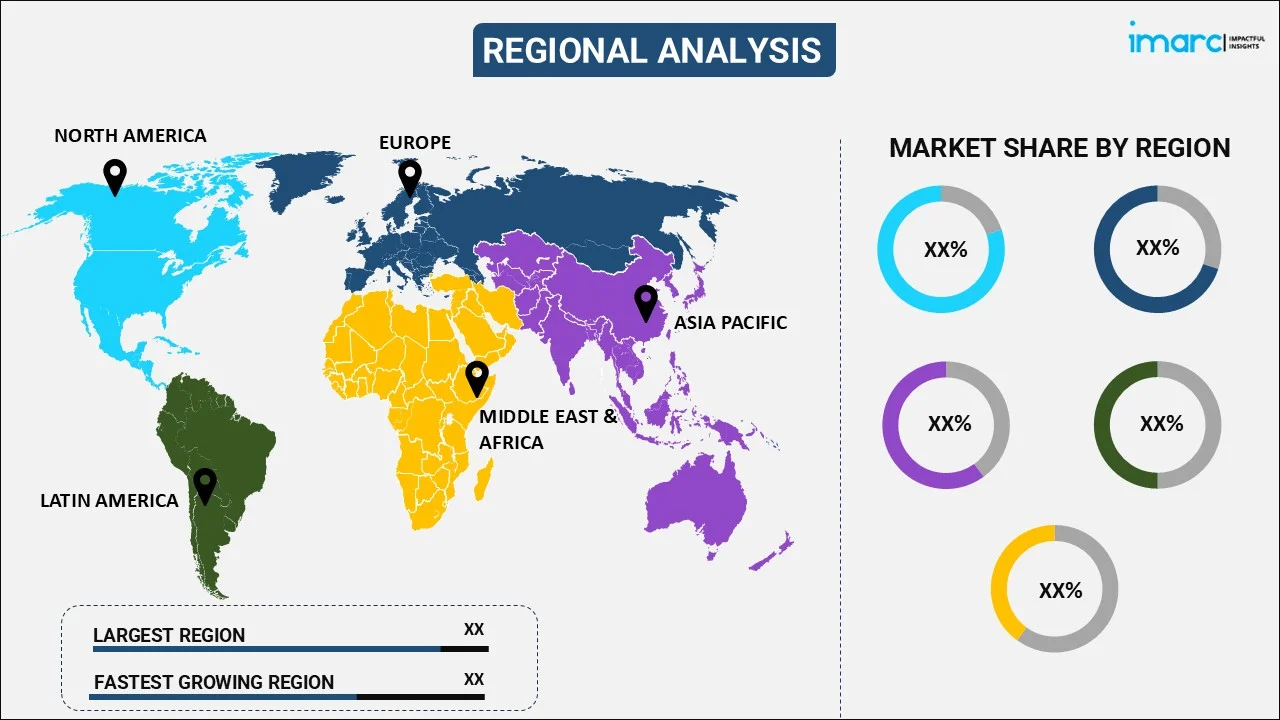
Agricultural Chelates Market Report by Type (Synthetic, Organic), Crop Type (Grains and Cereals, Pulses and Oilseeds, Commercial Crops, Fruits and Vegetables, Turf and Ornamentals), Application (Soil, Foliar, Fertigation, and Others), and Region 2025-2033
Agricultural Chelates Market Size:
The global agricultural chelates market size reached USD 750.8 Million in 2024. Looking forward, IMARC Group expects the market to reach USD 1,222.6 Million by 2033, exhibiting a growth rate (CAGR) of 5.57% during 2025-2033. The market is propelled by the rising demand for high-efficiency fertilizers, increasing awareness about sustainable agricultural practices, significant technological advancements in agricultural chelates, rapidly expanding agricultural sector, favorable government initiatives, and rapidly growing population globally and subsequent food demand.
|
Report Attribute
|
Key Statistics
|
|---|---|
|
Base Year
|
2024
|
|
Forecast Years
|
2025-2033
|
|
Historical Years
|
2019-2024
|
| Market Size in 2024 | USD 750.8 Million |
| Market Forecast in 2033 | USD 1,222.6 Million |
| Market Growth Rate (2025-2033) | 5.57% |
Agricultural Chelates Market Analysis:
- Major Market Drivers: The rising demand for good-quality crops, rising awareness about soil health and nutrient management, and increasing adoption of modern farming methods are some of the major market drivers of agricultural chelates.
- Key Market Trends: Some of the key market trends of the industry include significant technological advancements in chelation chemistry, growing awareness about sustainable agricultural practices, and rising demand for high-efficiency fertilizers.
- Geographical Trends: Asia Pacific dominates the market on account of the rapidly growing agricultural sector, favorable government initiatives and support, and rapidly growing population globally.
- Competitive Landscape: Akzo Nobel N.V., Aries Agro Ltd, BASF SE, Dow Inc., Haifa Negev Technologies Ltd., Mitsubishi Chemical Corporation, Nouryon, Nufarm Limited, Protex International SA, The Andersons Inc., Valagro (Syngenta AG), Van Iperen International B.V. and Yara International ASA., are among some of the key players in the agricultural chelates industry.
- Challenges and Opportunities: High cost of chelating agents in comparison to conventional fertilizers and restricted awareness and technology among famers are some of the challenges in the industry. Whereas, agricultural chelates market recent opportunities include entry of key players in untapped markets and significant development of innovative and organic chelating agents.

Agricultural Chelates Market Trends:
Rising Demand for High-Efficiency Fertilizers:
The agricultural industry is experiencing constant pressure to improve crop yields and quality on account of the rising global population and the rising need for sustainable food production. High-efficiency fertilizers including chelates are essential for meeting this demand, as they improve the availability and absorption of essential nutrients, including zinc, manganese, and iron which are vital for plant growth and productivity. Conventional fertilizers usually suffer from nutrient loss on account of volatilization, fixation in soil, and leaching. Using chelates reduce these losses by creating stable complexes with micronutrients thus making them readily available to plants even in adverse soil situations, this is further propelling the agricultural chelates industry. This efficiency optimizes crop yield along with minimizing the environmental impact of farming procedures.
Rising Awareness about Precision Agriculture
The rising awareness about precision agriculture is leading to a positive agricultural chelates market overview. This technique improves the efficiency of agricultural inputs such as fertilizers by allocating the appropriate amount of nutrients at the right time and place. The utilization of precision agriculture techniques substantially drives the demand for the product. Precision agriculture is dependent on data-driven insights from numerous technologies including soil sensors, GPS, satellite imagery, and drones to ascertain the nutrient status of the soil and the particular needs of crops. Chelates act in solidarity with these technologies with their superior nutrient delivery capabilities making sure that the use nutrients are effectively absorbed by the plants. As per a report by the IMARC GROUP, the precision agriculture market has reached US$ 8.5 Billion in 2023, and is expected to reach US$ 20.2 Billion by 2032, exhibiting a CAGR of 9.9% during 2024-2032.
Rising Soil Degradation and Nutrient Deficiency
Soil degradation and nutrient deficiency are vital issues that are impacting the agricultural productivity globally. Intensive farming practices, overgrazing, deforestation, and improper irrigation techniques are leading to substantial soil erosion, nutrient depletion, and loss of organic matter. This degradation leads to minimized soil fertility, directly impacting crop yield and quality. The agricultural chelates demand is constantly increasing as it caters to these issues by enhancing nutrient availability and soil health. Chelates function by establishing stable complexes with vital micronutrients, counteracting them from becoming unavailable to plants on account of soil fixation or pH changes. According to a FOOD AND AGRICULTURE ORGANIZATION (FAO), 33% of land till date is moderately to highly degraded on account of salinization, erosion, compaction, acidification, and chemical pollution of soils.
Agricultural Chelates Industry Segmentation:
IMARC Group provides an analysis of the key trends in each segment of the market, along with forecasts at the global, regional, and country levels for 2025-2033. Our report has categorized the market based on type, crop type, and application.
Breakup by Type:

- Synthetic
- EDTA
- EDDHA
- DTPA
- IDHA
- Others
- Organic
- Lignosulfonates
- Aminoacids
- Heptagluconates
- Others
Synthetic accounts for the majority of the market share
The agricultural chelates market report has provided a detailed breakup and analysis of the market based on the type. This includes synthetic (EDTA, EDDHA, DTPA, IDHA, and others) and organic (lignosulfonates, aminoacids, heptagluconates, and others). According to the report, synthetic represented the largest segment.
The synthetic segment dominates the market on account of its outstanding stability, efficacy, and economical nature. Synthetic chelates including EDTA (ethylenediaminetetraacetic acid) and DTPA (diethylenetriaminepentaacetic acid), are highly adopted in agriculture as they create highly stable complexes with micronutrients, making sure that their availability to plants in challenging soil conditions. The production procedure of synthetic chelates also enables for large-scale production, which assists in meeting the rising demand from the agricultural sector efficiently. The economic nature of synthetic chelates along with their high performance makes them a popular choice for farmers seeking to improve crop yields and quality.
Breakup by Crop Type:
- Grains and Cereals
- Pulses and Oilseeds
- Commercial Crops
- Fruits and Vegetables
- Turf and Ornamentals
Grains and cereals hold the largest share in the industry
A detailed breakup and analysis of the market based on the crop type have also been provided in the report. This includes grains and cereals, pulses and oilseeds, commercial crops, fruits and vegetables, and turf and ornamentals. According to the report, grains and cereals accounted for the largest market share.
Grains and cereals hold maximum number of agricultural chelates market share on account of their major role in global food security and agricultural economies. These crops such as rice, corn, wheat, and barley, are staple foods for a major population of the globe. According to GITNUX, rice is a major food for more than half of the global population. The report also states that Asia holds over 90% of the global rice production. Agricultural chelates are specifically advantageous for these crops as they effectively cater to micronutrient deficiencies, which are important for optimal growth and development. Furthermore, the rising global population and the increasing demand for food grains have made the adoption of advanced agricultural inputs imperative.
Breakup by Application:
- Soil
- Foliar
- Fertigation
- Others
Foliar represents the leading market segment
The report has provided a detailed breakup and analysis of the market based on the application. This includes soil, foliar, fertigation, and others. According to the report, foliar represented the largest segment.
Foliar hods maximum number of shares on account of its excellent efficacy in delivering vital nutrients immediately to the plant leaves, where they are instantly absorbed and utilized. This methodology surpasses soil-related problems, such as leaching and nutrient fixation, safeguarding a higher percentage of the applied nutrients for the plants. Foliar feeding is specifically effective for catering to the micronutrient deficiencies speedily, as it enables the immediate correction of nutrient imbalances and encourages healthier plant growth, thereby creating a positive agricultural chelates outlook. Other than this, the foliar application is advantageous in situations where soil conditions are suboptimal, including high pH or saline soils, where nutrient availability is often restricted.
Breakup by Region:

- North America
- United States
- Canada
- Asia-Pacific
- China
- Japan
- India
- South Korea
- Australia
- Indonesia
- Others
- Europe
- Germany
- France
- United Kingdom
- Italy
- Spain
- Russia
- Others
- Latin America
- Brazil
- Mexico
- Others
- Middle East and Africa
Asia Pacific leads the market, accounting for the largest agricultural chelates market share
The market research report has also provided a comprehensive analysis of all the major regional markets, which include North America (the United States and Canada); Asia Pacific (China, Japan, India, South Korea, Australia, Indonesia, and others); Europe (Germany, France, the United Kingdom, Italy, Spain, Russia, and others); Latin America (Brazil, Mexico, and others); and the Middle East and Africa. According to the report, Asia Pacific accounted for the largest market share.
Asia Pacific dominates the market as they possess a large and rapidly growing agricultural sectors, specifically in nations such as India, China, and Southeast Asia. According to the IMARC GROUP, the Indian farming market size reached INR 27,790.9 Billion in 2023 and is expected to reach INR 62,176.8 Billion by 2032, exhibiting a growth rate of 9.1% during 2024-2032. The need to increase crop yields in order to cater to the food demands for the increasing population across the region is propelling the agricultural chelates market growth. Additionally, the increasing awareness among farmers about the benefits of chelates for enhancing crop productivity and quality is contributing to the agricultural chelates market revenue. Other than this, the rising governmental support and initiatives direct at developing agriculture and promoting sustainable farming practices.
Competitive Landscape:
- The market research report has also provided a comprehensive analysis of the competitive landscape in the market. Detailed profiles of all major companies have also been provided. Some of the major market players in the Agricultural Chelates industry include Akzo Nobel N.V., Aries Agro Ltd, BASF SE, Dow Inc., Haifa Negev Technologies Ltd., Mitsubishi Chemical Corporation, Nouryon, Nufarm Limited, Protex International SA, The Andersons Inc., Valagro (Syngenta AG), Van Iperen International B.V. and Yara International ASA.
(Please note that this is only a partial list of the key players, and the complete list is provided in the report.) - Prominent agricultural chelates companies are making numerous efforts to improve their market presence and cater to the increasing demand for efficient and sustainable nutrient solutions. One of the most common efforts include the extensive research and development (R&D) activities in order to renovate and enhance chelate formulations. Key players are emphasizing on developing biodegradable and organic chelates that align with sustainable agricultural practices and minimize environmental impact. Other than this, key players are also entering into strategic steps such as mergers and acquisitions (M&A), and partnerships in order to improve their product portfolio and enter into untapped markets. For instance, in January 2023 NOURYON announced the acquisition of ADOB in order improve the product portfolio of NOURYON.
Latest News:
- May 2023: The Andersons, Inc. is pleased to announce its Plant Nutrient facility in Sergeant Bluff, Iowa, has achieved ResponsibleAg certification. The ResponsibleAg Certification Program is the only program in the nation that provides a voluntary comprehensive assessment of agricultural facilities that store and handle farm input supplies such as fertilizer, crop protection products, seed and fuel.
- March 2023: Syngenta Crop Protection partners with Aphea.Bio to bring novel agricultural technology to markets across Europe. The collaboration aims to accelerate the introduction of a novel biological seed treatment solution across multiple countries in Europe over the next five years, pending regulatory approval. This places a much-needed technology in the hands of farmers seeking to improve the sustainability of their farming operations, and to address challenges arising from an increasingly constrained toolbox of available agricultural technologies as well as evolving consumer demands.
Agricultural Chelates Market Report Scope:
| Report Features | Details |
|---|---|
| Base Year of the Analysis | 2024 |
| Historical Period | 2019-2024 |
| Forecast Period | 2025-2033 |
| Units | Million USD |
| Scope of the Report | Exploration of Historical Trends and Market Outlook, Industry Catalysts and Challenges, Segment-Wise Historical and Future Market Assessment:
|
| Types Covered |
|
| Crop Types Covered | Grains and Cereals, Pulses and Oilseeds, Commercial Crops, Fruits and Vegetables, Turf and Ornamentals |
| Applications Covered | Soil, Foliar, Fertigation, Others |
| Regions Covered | Asia Pacific, Europe, North America, Latin America, Middle East and Africa |
| Countries Covered | United States, Canada, Germany, France, United Kingdom, Italy, Spain, Russia, China, Japan, India, South Korea, Australia, Indonesia, Brazil, Mexico |
| Companies Covered | Akzo Nobel N.V., Aries Agro Ltd, BASF SE, Dow Inc., Haifa Negev Technologies Ltd., Mitsubishi Chemical Corporation, Nouryon, Nufarm Limited, Protex International SA, The Andersons Inc., Valagro (Syngenta AG), Van Iperen International B.V., Yara International ASA, etc. |
| Customization Scope | 10% Free Customization |
| Post-Sale Analyst Support | 10-12 Weeks |
| Delivery Format | PDF and Excel through Email (We can also provide the editable version of the report in PPT/Word format on special request) |
Key Benefits for Stakeholders:
- IMARC’s industry report offers a comprehensive quantitative analysis of various market segments, historical and current market trends, market forecasts, and dynamics of the agricultural chelates market from 2019-2033.
- The research report provides the latest information on the market drivers, challenges, and opportunities in the global agricultural chelates market.
- The study maps the leading, as well as the fastest-growing, regional markets. It further enables stakeholders to identify the key country-level markets within each region.
- Porter's five forces analysis assists stakeholders in assessing the impact of new entrants, competitive rivalry, supplier power, buyer power, and the threat of substitution. It helps stakeholders to analyze the level of competition within the agricultural chelates industry and its attractiveness.
- The competitive landscape allows stakeholders to understand their competitive environment and provides insight into the current positions of key players in the market.
Key Questions Answered in This Report
The global agricultural chelates market was valued at USD 750.8 Million in 2024.
We expect the global agricultural chelates market to exhibit a CAGR of 5.57% during 2025-2033.
The rising utilization of agricultural chelates to increase micronutrient efficiency, prevent loss of nutrients through washout, and reduce the growth of plant pathogens, is primarily driving the global agricultural chelates market.
The sudden outbreak of the COVID-19 pandemic had led to the implementation of stringent lockdown regulations across several nations resulting in the temporary halt in numerous agricultural practices and shortage of skilled laborers, thereby limiting the demand for agricultural chelates.
Based on the type, the global agricultural chelates market can be segmented into synthetic and organic. Currently, synthetic holds the majority of the total market share.
Based on the crop type, the global agricultural chelates market has been divided into grains and cereals, pulses and oilseeds, commercial crops, fruits and vegetables, and turf and ornamentals. Among these, grains and cereals currently exhibit a clear dominance in the market.
Based on the application, the global agricultural chelates market can be categorized into soil, foliar, fertigation, and others. Currently, foliar accounts for the largest market share.
On a regional level, the market has been classified into North America, Asia-Pacific, Europe, Latin America, and Middle East and Africa, where Asia-Pacific currently dominates the global market.
Some of the major players in the global agricultural chelates market include Akzo Nobel N.V., Aries Agro Ltd, BASF SE, Dow Inc., Haifa Negev Technologies Ltd., Mitsubishi Chemical Corporation, Nouryon, Nufarm Limited, Protex International SA, The Andersons Inc., Valagro (Syngenta AG), Van Iperen International B.V., and Yara International ASA.
Need more help?
- Speak to our experienced analysts for insights on the current market scenarios.
- Include additional segments and countries to customize the report as per your requirement.
- Gain an unparalleled competitive advantage in your domain by understanding how to utilize the report and positively impacting your operations and revenue.
- For further assistance, please connect with our analysts.
 Request Customization
Request Customization
 Speak to an Analyst
Speak to an Analyst
 Request Brochure
Request Brochure
 Inquire Before Buying
Inquire Before Buying




.webp)




.webp)












